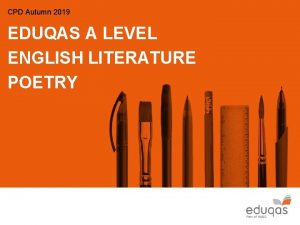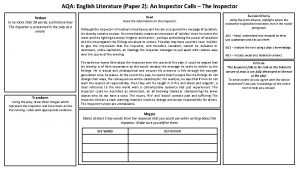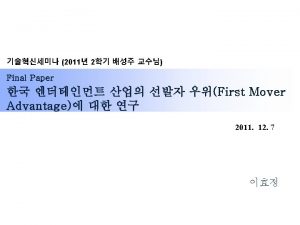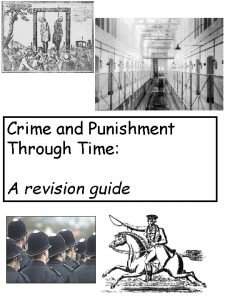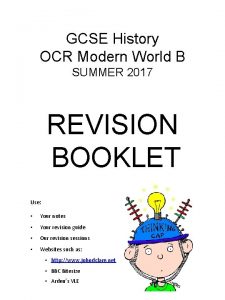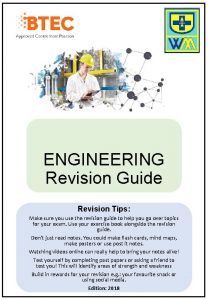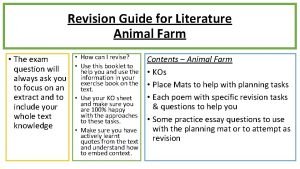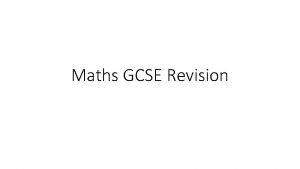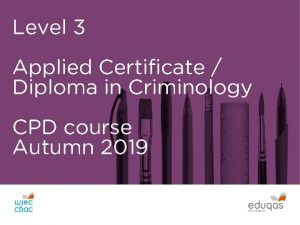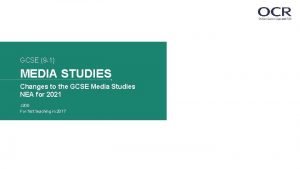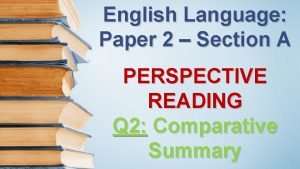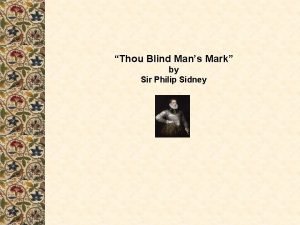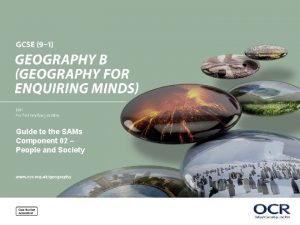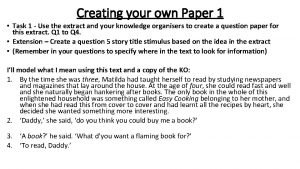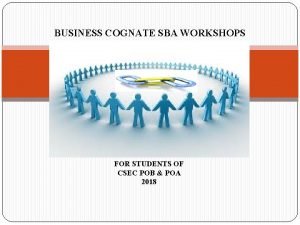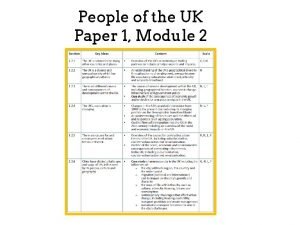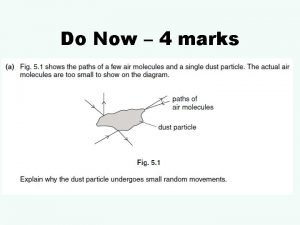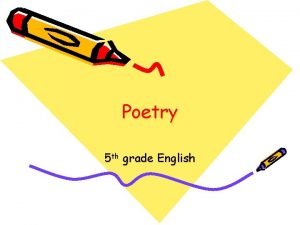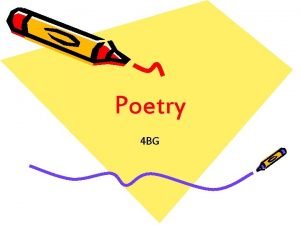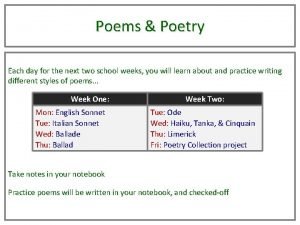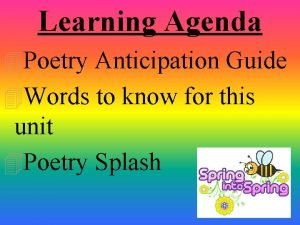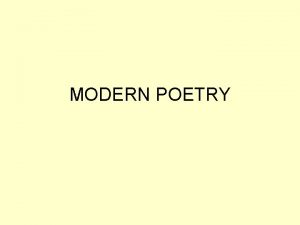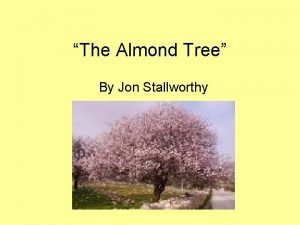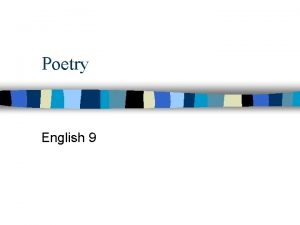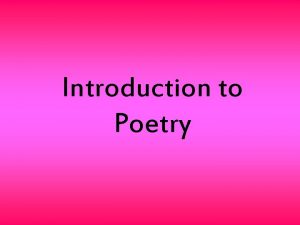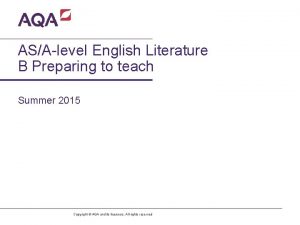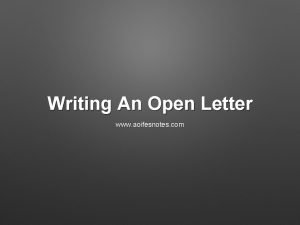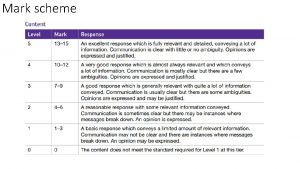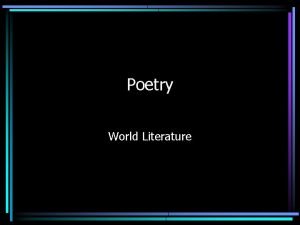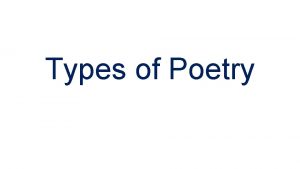Literature Poetry Revision Guide Contents Advice Mark Scheme



















































- Slides: 51

Literature Poetry Revision Guide

Contents • Advice • Mark Scheme • The Poems/Notes – – – • • • Armitage - Hitcher Armitage - Homecoming Armitage - Mother Armitage - Kid Duffy - Before You Were Mine Duffy - Anne Hathaway Duffy - Havisham Duffy - Stealing Pre-1914 - Sonnet 130 Pre-1914 - My Last Duchess Pre-1914 - On My First Sonne Pre-1914 - The Laboratory Example Response MITSL- TSLAP Past Exam Questions Independent Learning/Homework Comparison Chart

Advice

Advice – The Exam • You will be asked to compare FOUR poems in your exam. Either ONE or TWO poems will be named (you have to write about them) and you will be asked to compare these to each other and two other poems. Two poems will be from the Pre-1914 section, one from Duffy and one from Armitage. • You have one hour to complete this. Practice spending 5 mins planning and timing yourself writing a structured response. • You MUST revise. You have a wealth of materials available and you are capable of doing better than you imagine if you revise!

Advice – Reading Poems • Look for patterns, repetitions, repeated words, phrases, ideas – and developments of these in the poem (maybe draw pencil ‘arrows’ between them) • What links can you make between the title and the actual words of the poem? Pick out and list some specific vocabulary. Make a note of line numbers. • What word ‘pictures’ or images can you find within the poem? Use circles in the margin to mark them • What do you notice about the punctuation and organisation of the poem into lines and verses? Where does your eye tell you to stop? Where does the punctuation tell you to stop? Count the sentences; count the lines; count the stanzas. • What do you notice about the ‘shape’ of the poem? What does it look like on the page (this is called form or structure). Write some very brief notes to show the poem is organised.

Advice – Structuring a Response Stage 1: The Introduction • Your introduction needs to do the following: – Address the terms of the question referring directly to the key words of the question; – Some conceptual discussion of the key concept in the title question; – An initial comparison of how the key concept in the title question is presented in each poem – you need to make sure you include in this the titles and names of the poets you are going to discuss. Stage 2: Body Paragraphs • Each body paragraph needs to do the following: – Make a point of comparison between the poems in direct response to the title question; – Embed useful and pertinent details from the text to support your argument; – Make some detailed comment about how language, form or structure compare; – Explore meaning commenting how language, form or structure contribute to the overall meaning; – Conclude with a comparative remark that is directly related to the title question. – Throughout you should use discourse markers to show you are making comparison. Stage 3: Conclusion • Your conclusion needs to do the following: – Directly answer the title question based on the exploration of the poems that you have completed; – Make some comparative remarks in relation to the title question.

Advice – Structuring Paragraphs • If you follow the advice you have been given about how best to plan and structure an essay on the Literature Poetry, you should know roughly what ideas and points you are going to cover in each of your paragraphs before you begin writing the essay. In general, each paragraph should deal with one main topic or idea and it may be helpful if you include the following elements to each paragraph. – An outline of your argument or point (this should really refer to key words in the question or address issues which it raises). – A quotation and/ or other detailed reference to the poem named in the question which will support your point. – A comment on the quotation which will help to explain why you have chosen it and may analyse the language in it. – A point of comparison between the named poem and one or more other poem(s). • Remember that you will need to indent, or leave a line between, each paragraph and a paragraph should usually contain more than one sentence.

Mark Scheme

A* A B C D

Simon Armitage

Hitcher I'd been tired, under the weather, but the ansaphone kept screaming: One more sick-note, mister, and you're finished. Fired. I thumbed a lift to where the car was parked. A Vauxhall Astra. It was hired. I picked him up in Leeds. He was following the sun to west from east with just a toothbrush and the good earth for a bed. The truth he said, was blowin' in the wind, or round the next bend. I let him have it on the top road out of Harrogate - once with the head, then six times with the krooklok in the face - and didn't even swerve. I dropped it into third and leant across to let him out, and saw him in the mirror bouncing off the kerb, then disappearing down the verge. We were the same age, give or take a week. He'd said he liked the breeze to run its fingers through his hair. It was twelve noon. The outlook for the day was moderate to fair. Stitch that, I remember thinking, you can walk from there.

Hitcher This poem comes from Book of Matches but is a longer poem than the “matches” - and has its own title. It is a monologue of sorts, in which a man confesses to murder. We notice that he is at once like, and yet unlike, his victim. Briefly, the speaker in the poem has been taking time off work - feigning illness and not answering his phone. Being threatened with the sack (losing his job), he goes in to work again. He gets a lift to his hired car (a short distance we suppose). As he drives out of Leeds he picks up a hitchhiker who is travelling light and has no set destination. Some little way later (coming out of Harrogate) he attacks his passenger, and throws him out of the still-moving car. The last he sees of the hiker, he is “bouncing off the kerb, then disappearing down the verge” - we do not know if he is dead or just badly injured. The driver does not care. The two men have some things in common - what are they? Both hitch lifts, and They are more or less of the same age. Can you think of anything else? On the other hand, they differ in lots of ways: One hitches to a specific place for a specific reason; the other is following the sun. One is going to work; the other appears not to work. One navigates by town and city names; the other by points of the compass. One is a victim of his work; the other has a carefree attitude. One learns about weather from the forecast; the other loves sun and wind. The contrast also appears in the way the men speak. The driver repeats the language of the weather forecast “moderate to fair” and the driverspeak of dropping “into third” while the hitcher uses hippie clichés about the good earth as his bed, about the truth, in the words of Bob Dylan's song “blowin' in the wind” and even a metaphor of the breeze running “its fingers/through his hair”. The driver is quite materialistic - he refers to the ansaphone, the Vauxhall Astra, the krooklok and the mirror. We may judge the driver not only by his violent attack but also by his boss's threat - this suggests that he is not really ill, but is a malingerer. So “tired” and “under the weather” are not convincing - though “weather” here has an echo in the “outlook for the day” in the final stanza. And the driver is a coward - his argument is with his boss or his own way of life. But he attacks the hitcher, whose carefree values seem almost to mock him. The poem is arranged in five stanzas, each of five lines - and most end with a full or half rhyme. But the arrangement is more for the eye than the ear - the lines are not all endstopped and the poem, read aloud, sounds as expansive as natural speech.

Homecoming Think, two things on their own and both at once. The first, that exercise in trust, where those in front stand with their arms spread wide and free-fall backwards, blind, and those behind take all the weight. The second, one canary-yellow cotton jacket on a cloakroom floor, uncoupled from its hook, becoming scuffed and blackened underfoot. Back home the very model of a mother, yours, puts two and two together, makes a proper fist of it and points the finger. Temper, temper. Questions in the house. You seeing red. Blue murder. Bed Then midnight when you slip the latch and sneak no further than the call-box at the corner of the street; I’m waiting by the phone, although it doesn’t ring because it’s sixteen years or so before we’ll meet. retrace that walk towards the garden gate; in silhouette a father figure waits there, wants to set things straight. These ribs are pleats or seams. These arms are sleeves. These fingertips are buttons, or these hands can fold into a clasp, or else these fingers make a zip or buckle, you say which. Step backwards into it and try the same canary-yellow cotton jacket, there, like this, for size again. It still fits.

Simon Armitage Meaning The poem is about relationships and trust. It opens with the description of a 'trust exercise', often used in school drama lessons. Next, a child (almost certainly a teenager) is told off by their mother for having allowed their yellow jacket to get dirty; a row develops. The child is sent to their room, but sneaks out at the dead of night to a phone box: interestingly, the narrator of the poem is waiting by the phone, but it doesn't ring. The child then returns home and meets a father figure who wants to make up. Stanza 4 deals with the reconciliation - a 'father figure' is asking a child to try on the yellow coat again, by stepping backwards into it, like in the trust exercise of stanza 1. It's not clear who this father figure is: perhaps it's the narrator's father, still in memory; perhaps it is the narrator himself addressing his childhood self (it's sixteen years or so before we'll meet); perhaps he is talking now to a friend or lover to whom the yellow coat incident happened when they were a child; perhaps it is the narrator, now a father, addressing his own child. Imagery The exercise in trust in stanza 1 is clearly a metaphor for trust in real life situations. In the exercise, the person falling trusts that they will be caught by those behind them. In the minefield of personal relationships, you rely upon family and friends to 'catch' you. The second stanza is full of colour. The jacket is canary-yellow (line 5) and becomes blackened (line 7). The child see[s] red - Armitage chose a phrase that uses colour to depict anger - and Blue murder is threatened. Yellow, red and blue are the primary colours: perhaps Armitage used these to show vivid and 'colourful' the child's memories of the row are - it is obviously still important to him many years later. The mother is described as the very model of a mother (line 8). Does this suggest that she is a typical mother figure (as if like a child's model toy, reproduced in a factory) or a more-than-perfect mother (model as an adjective can mean 'ideally perfect')? Either way, she makes the wrong assumption about how the jacket got dirty - in the child's eyes, as least. It is midnight when the child escapes to the phone box - always a time when special things may happen! This call seems to have been a symbolic attempt to get in touch with his future adult self. The father figure (line 17) is in silhouette: the child can see his shape, but not his whole body. Does this suggest that their relationship with him is not now as 'rounded' as a result of the row? It is not definite that he is the child's actual father - only a father figure. The fact that he is waiting outside shows that he is concerned for the welfare of the child, but also that he wants to set things straight (line 17) - perhaps implying that the argument is not over yet! The final stanza is an extended metaphor. The embrace between the child and the family is likened to putting on the yellow jacket that caused the row in the first place. Parts of the body become parts of the jacket, to show us how warm and loving the hug is. The poet does not know exactly what the jacket looks like - these fingers make a zip / or buckle, you say which (line 20), but it does not matter as It still fits (line 23). In other words, continuity is restored, the family is whole again. Sound We can 'hear' some of the family row. Stanza two has many short phrases, showing tension rising in the household. Armitage uses colloquial phrases like Temper, temper that the child and the mother may actually have spoken. Bed (line 11) could be the order of a furious parent: we can imagine their finger pointing towards the door!

Tone/Ideas Structure Much of the meaning of a poem is conveyed by the attitude it expresses toward its subject matter. 'Attitude' can be thought of as a combination of the poet's tone of voice, and the ideas he or she is trying to get across to the reader. A good way to decide on the tone of a poem is to work out how you would read it aloud. Should the poem be read: § with warmth, to emphasise the love between the family (and between the poet and the child) § wistfully, to emphasise his sadness at a painful childhood memory § with irony, as the poet reflects on an episode of (possibly) poor parenting, and on what he has learnt since he himself was a child There is probably a bit of all three, and the tone you adopt will depend in part on who you think the 'you' in the second half of the poem is. Certainly the tone at the end of the poem is overwhelmingly one of warmth and connection between parent and child. The poem consists of 4 stanzas of varying lengths (4 lines, 7 lines, 6 lines). The lines are roughly equal in length, ranging from 9 to 13 syllables. The verse is therefore quite irregular (it doesn't fit a strict pattern), perhaps reflecting the idea in the poem that relationships can be awkward and don't follow a set pattern Language Think about how the language the poet uses helps to convey his ideas. Here are some points to consider: §Consider the title of the poem. There are two homecomings described - one, when the child arrives back with a dirty jacket which leads to a family row, and one when the family embraces and all is forgiven. The second homecoming is the most significant: the child is welcomed 'home' into the love of the family. §Armitage gives us instructions on how to read the poem. We are invited in the first line to Think, two things on their own and both at once. He is alerting us to the idea that two apparently very different things - the trust exercise and the row over the jacket - can be linked. He does not refer to the comparison again until the final lines of the poem. §We are presented with little sketches. We are given only sparse details. Although we know the colour of the jacket, we do not know about its owner or their family. They are anonymous. We are not even sure whether the child is a boy or a girl - although the colour of the jacket may make people assume that is a girl. Nor do we know anything about the narrator figure. Yet it doesn't matter: both boys and girls fall out with their parents at times. By leaving out personal details, Armitage is directing his message at everyone: he is perhaps acknowledging that bad rows start with the simplest things. §Much of the poem is written in the second person, directed to You. The first person. I is not introduced until the third stanza. The relationship between the grown-up child and the persona of the poet must be close, because the child is confiding something that must have troubled them for a long time. §We are not told exactly what happened to cause the row. The jacket was uncoupled from its hook and let to get dirty on the floor of the cloakroom (presumably at school). The child's mother accuses the child - points the finger (line 10) - perhaps of being careless, someone not to be trusted, although the child obviously feels misjudged: the mother makes a proper fist of it (line 9). The phrase Temper, temper (line 10) is sometimes humorous, but here it seems more serious: perhaps both mother and child are in a temper, which causes the child to be sent to bed acrimoniously. §Even though it deals with events spanning 16 years, the poem is mostly in the present tense, which gives immediacy (we feel it is happening now) and adds tension. §The link between the trust exercise and the jacket is developed in the closing lines. Step backwards into it / and try the same canary-yellow cotton jacket. The embrace between the child and their parents is likened to falling backwards, as in a trust exercise. It shows that trust within the family has been restored: the child trusts their parents once more. I'm waiting by the phone, although it doesn't ring. . The poet suggests that he is somehow anticipating his friendship with the grown-up child. It suggests he is there to offer help whenever it is needed. Questions / in the House. The line refers to the questions the mother is asking the child about the jacket; but you may have heard the phrase 'Questions in the House' before - it is used to describe Questions to a minister in the House of Commons. The issue is clearly crucial to her! these hands can fold / into a clasp. . . Armitage is using a pun on clasp to emphasise the closeness of family. A clasp can be a fastening on a jacket, but also means a tight hold on something or someone. The child and their parents are 'clasping' each across the generations other now that they have made up.

“Mother, any distance greater than a single span” Mother, any distance greater than a single span requires a second pair of hands. You come to help me measure windows, pelmets, doors, the acres of the walls, the prairies of the floors. You at the zero-end, me with the spool of tape, recording length, reporting metres, centimetres back to base, then leaving up the stairs, the line still feeding out, unreeling years between us. Anchor. Kite. I space-walk through the empty bedrooms, climb the ladder to the loft, to breaking point, where something has to give; two floors below your fingertips still pinch the last one-hundredth of an inch… I reach towards a hatch that opens on an endless sky to fall or fly.

“Mother, any distance greater than a single span” Book of Matches (1993) is a collection of poems without titles. Each poem is meant to be read in the time it takes a match to burn down - about twenty seconds, unless you want to burn your fingers. There is a pun in the title: we call a packet from which we tear out the matches a book, but this is also a book in the normal sense, with words for us to read. The speaker in the poem (who may be the poet himself) is measuring up a house - it appears that he is moving in, and is measuring for curtains and carpets. His mother has “come to help” him as he needs “a second pair of hands” to measure distances greater than the span of his two arms. (“Span” as a measurement traditionally refers to a handspan, from thumb to little finger when the hand is splayed. ) While his mother stays put, he reels out a tape measure, calling figures for her to record. Eventually he reaches the limit of the tape - as he looks at an open hatch, opening on an “endless sky”. He imagines himself passing through this - “to fall or fly”. The poem explores the emotional connection of mother and child (we may assume it is a son, but if the poem is not autobiographical, there is no real reason why the speaker should not be a daughter). The tape measure becomes a metaphor for this. Now the child is ready to let go, but is unsure whether he can succeed on his own. The reeling out of the tape is like the passing of the years - and the poet compares it to other kinds of line. Perhaps his mother is an anchor and he is a kite - this may bring security but may also limit his freedom to fly. Yet another image of attachment comes in the suggestion that the poet is space-walking - the phrase is a pun, as he is also walking through the “empty” space of the bedroom. The “last one hundredth of an inch” marks the limit of the tape measure - beyond this, the speaker has to let go (or break the tape). The conclusion of the poem is ambiguous, but reflects a real experience most of us undergo, not knowing whether independence is a chance for us to thrive or to fail. The mother's fingertips “still pinch” - she has come to help the child measure up, but now may be reluctant at the last to let go. The poem has an irregular rhyme scheme - including occasional internal rhyme. The speaker suggests the sense of adventure in leaving home with images of vast space “acres” and “prairies”, and “reporting. . . back to base”. The mother is seen as a fixed point in an uncertain world, but she is not stopping her child from moving out.

Kid Batman, big shot, when you gave the order to grow up, then let me loose to wander leeward, freely through the wild blue yonder as you liked to say, or ditched me, rather, in the gutter … well, I turned the corner. Now I've scotched that 'he was like a father to me' rumour, sacked it, blown the cover on that 'he was like an elder brother' story, let the cat out on that caper with the married woman, how you took her downtown on expenses in the motor. Holy robin-redbreast-nest-egg-shocker! Holy roll-me-over-in-the-clover, I'm not playing ball boy any longer Batman, now I've doffed that off-the-shoulder Sherwood-Forest-green and scarlet number for a pair of jeans and crew-neck jumper; now I'm taller, harder, stronger, older. Batman, it makes a marvellous picture: you without a shadow, stewing over chicken giblets in the pressure cooker; next to nothing in the walk-in larder, punching the palm of your hand all winter, you baby, now I'm the real boy wonder.

e g ita rm m Si A n o Meaning The poem is a dramatic monologue by Robin the Boy Wonder, the loyal sidekick to Batman in the comic strips, television programmes and films. Robin talks about how he has separated from Batman and is learning to lead his own, independent life. In the process he publicises some of Batman's secrets so that we see the 'superhero' in a new light. Robin ends up stronger and more mature. The poem is often humorous but has a serious message too. Imagery The imagery in the opening lines shows the contrast between the way Batman saw his separation with Robin, when he 'generously' let him free to explore the wild blue yonder (line 3), to Robin's more down to earth view of events - ditched me. . . in the gutter (line 5). We wonder what really happened between them. . . Robin uses various cliched phrases as he tells us that he has scotched that. . . rumour, sacked it, blown the cover. . . let the cat out (lines 6 -9), perhaps because he is boasting of the power that releasing these secrets has given him over Batman. The casual language makes it sound as if he is showing off to his mates. The casual use of motor for the Batmobile also suggests he is trying to impress us. The word caper (line 9) is a pun, reminding us of the capes that Batman and Robin always wore. Lines 12 and 13 are spoofs of tabloid headlines. Holy is an adjective that Robin used a lot when exclaiming, such as 'Holy smoke!' Here, Armitage has exaggerated it for comic effect. The 'new' Robin seems to be making fun of his 'old' self. Robin becomes scornful when he uses the metaphor I'm not playing ball boy any longer (line 14). He's fed up of the 'game' and doesn't want to serve anyone any more. He makes fun of his superhero outfit, again sounding scornful by describing it as a fashion writer might - that off-the-shoulder Sherwood-Forest-green and scarlet number (lines 15 -16). He prefers the more ordinary jeans and jumper, now that he is an ordinary kid. It is ironic that he calls Batman baby in the final line, because although it is a term of endearment, he uses it to belittle Batman. Robin the kid has grown up while Batman, the superhero, has diminished to a baby. The phrase boy wonder had a new meaning, because Robin has managed to break free of his idol.

Tone/Ideas Structure Much of the meaning of a poem is conveyed by the attitude it expresses toward its subject matter. 'Attitude' can be thought of as a combination of the poet's tone of voice, and the ideas he or she is trying to get across to the reader. To decide on the tone, you need to think about the ideas and attitudes in the poem, and then decide how you would read it aloud. The poem could be read: The poem consists of a single stanza of 24 lines. The lines are pentameters (they have 10 syllables each). You will have noticed that every line ends with er (order, wander, yonder). Think about the famous Batman theme tune: Er er er er, er er, Batman! This effect is intensified through the internal rhyme, as many words within the lines also end with -er or -our (gutter, rumour, elder) The very last words of the poem, announcing that Robin now is the real boy wonder (line 24), create the climax of the rhyme scheme. Armitage uses very long sentences: there are only 5 in the whole poem. This adds pace to the reading, as we are only allowed short pauses for breath, and helps to convey the energy that Robin has now he is free of Batman § in a bitter way, suggesting Robin is angry that Batman prevented him from growing up for so long § in a thoughtful way, suggesting that Robin is reflecting on his experiences with Batman § triumphantly, showing Robin's delight that he is free of Batman at last. § Most readers will probably feel that the tone should be mainly triumphantly, showing Robin's delight that he is free of Batman at last, yet it could be read thoughtfully. Language Think about the title. It does not tell us anything about Batman and Robin - it's only when we begin to read the poem that the identity of the 'kid' becomes clear. However, if we go back to the title having read the poem, it may remind us of other young people who are caught up in the shadow (line 20) of someone they admire, and their need to forge their own identity. Batman is at first presented as a real superhero: he is described at the start in the alliterative phrase Batman, big shot, as someone who gives orders to Robin. Yet as we read on, his status is diminished. We hear that he ditched (line 4) Robin and had an affair with a married woman (line 10). We see him at the end all alone, cooking an unappealing meal for himself (chicken giblets in the pressure cooker (line 21), with next to nothing (line 22) in the house to eat. Can it be that he cannot manage by himself, without Robin around? He is shown as anxious to get going, punching the palm of [his] hand (line 23) with boredom, but unable to do anything. This poem contains various examples of slang, for example naval slang - wander leeward (line 2), British slang - the ordinary word motor (line 11) for the amazing Batmobile, and American slang - baby (line 24). The mixture of styles adds humour and perhaps helps to illustrate the growing-up process: Robin is trying out a mixture of things. - There is a serious message behind the comedy - we are encouraged to consider whether heroes and hero-worship can really sustain young people growing up. However marvellous the admired person may be, a young person has to learn to be independent - taller, harder, stronger, older (line 18) and to live their own life

Carol Ann Duffy

Before You Were Mine I'm ten years away from the corner you laugh on with your pals, Maggie Mc. Geeney and Jean Duff. The three of you bend from the waist, holding each other, or your knees, and shriek at the pavement. Your polka-dot dress blows round your legs. Marilyn. I'm not here yet. The thought of me doesn't occur in the ballroom with the thousand eyes, the fizzy, movie tomorrows the right walk home could bring. I knew you would dance like that. Before you were mine, your Ma stands at the close with a hiding for the late one. You reckon it's worth it. The decade ahead of my loud, possessive yell was the best one, eh? I remember my hands in those high-heeled red shoes, relics, and now your ghost clatters toward me over George Square till I see you, clear as scent, under the tree, with its lights, and whose small bites on your neck, sweetheart? Cha cha! You'd teach me the steps on the way home from Mass, stamping stars from the wrong pavement. Even then I wanted the bold girl winking in Portobello, somewhere in Scotland, before I was born. That glamorous love lasts where you sparkle and waltz and laugh before you were mine.

Carol Ann Duffy Meaning §The poet is talking to her mother, having seen a photo of her mother as a teenager. §She describes the photo of her mother standing laughing with two of her friends. §She knows that the thought of having a child one day doesn't occur to her mother when young, when she was wrapped up in a world of dances and teenage dreams. §Now remembering her own childhood, the poet thinks of how she used to play with her mother's red shoes and imagines when her mother might have worn those shoes to meet a boyfriend in George Square (in Glasgow). §She remembers how her mother used to teach her dance steps when she was a child - yet even back then, the young poet wished she could have known her mother when still young and carefree, before she was a mother - 'Before you were mine'. Imagery The poem is dominated by the image of the family snap, the dog-eared photo that turns up many years after the event in a shoe-box or album, and leads to the (imaginary? ) conversation recorded in this poem. Interestingly, there is no actual mention of this photo; but we can see it clearly in the description of the threegirls-out-on-the-town scene in stanza 1. The poet deploys a great deal of glittering light to evoke the excitement of carefree teenage existence: the ballroom fizzes with light; the tree under which the mother is kissed has lights in it; mother and child stamp stars from the pavement as they cha-cha home from Mass; life before motherhood waltzes and sparkles.

Tone/Ideas Structure Much of the meaning of a poem is conveyed by the attitude it expresses toward its subject matter. 'Attitude' can be thought of as a combination of the poet's tone of voice, and the ideas he or she is trying to get across to the reader. A good way to decide on the tone of a poem is to work out how you would read it aloud. How would you read this poem? §admiringly, and with gratitude for the way her mother livened up her childhood - 'You'd teach me the steps on the way home from Mass' §wistfully, dwelling on the poet's own memories ('I remember my hands in those red high-heeled shoes') and imaginings ('your ghost clatters towards me') §ironically - contrasting the short-lived glamour of her mother's teenage life with the hard reality of motherhood §affectionately - almost a love poem to her mother Any of these tones would work. In fact the tone shifts subtly from one to another, ending on a note of enduring love between daughter and mother - 'That glamorous love' that lasts. The poem is written in four equal stanzas of five lines each. How does this help you to 'see' the poem? §It may help you to visualise photos in an album, set out regularly over a page. §It may help you to realise the regularity of time passing. (The poem keeps reminding us that ten years after the photo was taken, the happy, bold teenager had become a mother. ) Ideas The following ideas are all contained within the poem. Which do you think come across most strongly? §The poet romanticises her mother and the glamorous life she used to lead. §The poet longs to see her mother as she once was, before she was tied down with motherhood. §The poet recognises that all mothers have mothers - her mother's mother used to 'stand at the close with a hiding for the late one', perhaps as the poet's mother now watches out for her. . . The poet is re-examining her own feelings as a daughter. Language Think about how the language contributes to the mood of the poem. Here are some points to consider: §There are many references to her mother as happy and bright - 'you laugh / the bold girl winking in Portobello'. . . 'you sparkle and waltz and laugh' §Life back then is seen as very glamorous. Her mother is likened to Marilyn (Monroe) and goes to a dance where a glitter ball hangs - 'the thousand eyes'. Her mother drams of 'fizzy, movie tomorrows', and she imagines her mother meeting a boyfriend 'under the tree, with its lights'. §There is contrast between her mother's life as a teenager and as a mother of the young poet. The poet assumes her mother's life was better before her own possessive, loud yell was heard. The phrase 'I'm not here yet' sounds almost like a warning to her teenage mother-to-be that the fun will end when she arrives. §The poem is written in the present tense, as if the events of the photo are happening now. Why do you think this is? Is the poet trying to make her mother's past as real as possible? §The poet has a very confident, assertive voice, and makes definite statements: 'I'm not here yet'. She speaks to her mother in a familiar way: 'The decade ahead of my loud, possessive yell was the best one, eh? '

Anne Hathaway 'Item I gyve unto my wife my second best bed. . . ' (from Shakespeare's will) The bed we loved in was a spinning world of forests, castles, torchlight, clifftops, seas where we would dive for pearls. My lover's words were shooting stars which fell to earth as kisses on these lips; my body now a softer rhyme to his, now echo, assonance; his touch a verb dancing in the centre of a noun. Some nights, I dreamed he'd written me, the bed a page beneath his writer's hands. Romance and drama played by touch, by scent, by taste. In the other bed, the best, our guests dozed on, dribbling their prose. My living laughing love I hold him in the casket of my widow's head as he held me upon that next best bed.

Anne Hathaway (1556 -1623) was a real woman - famous for being the wife of William Shakespeare. (We do know some things about her - she was nine years older than her husband, but outlived him by seven years. They married in 1582, when Anne was already pregnant, and had three children together. Although Shakespeare spent many years working in London, he made frequent visits to their home in Stratford-upon-Avon. ) In the poem Anne sees her relationship with Shakespeare in terms of his own writing. She uses the sonnet form (though she does not follow all the conventions of rhyme or metre) which Shakespeare favoured. She suggests that as lovers they were as inventive as Shakespeare was in his dramatic poetry - and their bed might contain “forests, castles, torchlight”, “clifftops” and “seas where he would dive for pearls”. These images are very obviously erotic, and Ms. Duffy no doubt expects the reader to interpret them in a sexual sense. Where Shakespeare's words were” shooting stars” (blazing in glory across the sky) for her there was the more down-to-earth consequence of “kisses/on these lips”. She also finds in the dramatist's technique of “rhyme. . . echo. . . assonance” a metaphor for his physical contact - a “verb” (action) which danced in the centre of her “noun”. Though the best bed was reserved for the guests, they only dribbled “prose” (inferior pleasure) while she and her lover, on the second best bed enjoyed the best of “Romance/and drama”. The language here has obvious connotations of sexual intercourse - we can guess what his verb and her noun are and what the one is doing in the other, while the guests' “dribbling” suggests a less successful erotic encounter. The poem relies on double meanings very like those we find in Shakespeare's own work. It gives a voice to someone of whom history has recorded little. The language is strictly too modern to be spoken by the historical Anne Hathaway (especially the word order and the meanings) but the lexicon (vocabulary) is not obviously anachronistic - that is, most of the words here could have been spoken by the real Anne Hathaway, though not quite with these meanings and probably not in this order.

Havisham Beloved sweetheart bastard. Not a day since then I haven't wished him dead. Prayed for it so hard I've dark green pebbles for eyes, ropes on the back of my hands I could strangle with. Spinster. I stink and remember. Whole days in bed cawing Nooooo at the wall; the dress yellowing, trembling if I open the wardrobe; the slewed mirror, full-length, her, myself, who did this to me? Puce curses that are sounds not words. Some nights better, the lost body over me, my fluent tongue in its mouth in its ear then down till suddenly bite awake. Love's hate behind a white veil; a red balloon bursting in my face. Bang. I stabbed at a wedding cake. Give me a male corpse for a long slow honeymoon. Don't think it's only the heart that b-b-b-breaks.

Havisham This poem is a monologue spoken by Miss Havisham, a character in Dickens' Great Expectations. Jilted by her scheming fiancé, she continues to wear her wedding dress and sit amid the remains of her wedding breakfast for the rest of her life, while she plots revenge on all men. She hates her spinster state - of which her unmarried family name constantly reminds her (which may explain the choice of title for the poem). She begins by telling the reader the cause of her troubles - her phrase “beloved sweetheart bastard” is a contradiction in terms (called an oxymoron). She tells us that she has prayed so hard (with eyes closed and hands pressed together) that her eyes have shrunk hard and her hands have sinews strong enough to strangle with - which fits her murderous wish for revenge. (Readers who know Dickens' novel well might think at this point about Miss Havisham's ward, Estella - her natural mother, Molly, has strangled a rival, and has unusually strong hands. ) Miss Havisham is aware of her own stink - because she does not ever change her clothes nor wash. She stays in bed and screams in denial. At other times she looks and asks herself “who did this” to her? She sometimes dreams almost tenderly or erotically of her lost lover, but when she wakes the hatred anger return. Thinking of how she “stabbed at the wedding cake” she now wants to work out her revenge on a “male corpse” - presumably that of her lover. The poem is written in four stanzas which are unrhymed. Many of the lines run on, and the effect is like normal speech. The poet • uses many adjectives of colour - “green”, “puce”, “white” and “red” and • lists parts of the body “eyes”, “hands”, “tongue”, “mouth”, “ear” and “face”. Sometimes the meaning is clear, but other lines are more open - and there are hints of violence in “strangle”, “bite”, “bang” and “stabbed”. It is not clear what exactly Miss Havisham would like to do on her “long slow honeymoon”, but we can be sure that it is not pleasant. • Why does the poet omit Miss Havisham's title and refer to her by her surname only? • Why does the poet write “spinster” on its own? What does Miss Havisham think about this word and its relevance to her? • What is the effect of “Nooooo” and “b-b-breaks”? Why are these words written in this way? • What is the meaning of the image of “a red balloon bursting”? • How far does the poet want us to sympathize with Miss Havisham? • Does the reader have to know about Great Expectations to understand the poem? • Does Miss Havisham have a fair view of men? What do you think of her view of being an unmarried woman? Perhaps the most important part of the poem is the question “who did this/to me? ” How far does the poem show that Miss Havisham is responsible for her own misery, and how far does it support her feelings of self-pity and her desire for revenge?

Stealing The most unusual thing I ever stole? A snowman. Midnight. He looked magnificent; a tall, white mute beneath the winter moon. I wanted him, a mate with a mind as cold as the slice of ice within my own brain. I started with the head. Better off dead than giving in, not taking what you want. He weighed a ton; his torso, frozen stiff, hugged to my chest, a fierce chill piercing my gut. Part of the thrill was knowing that children would cry in the morning. Life's tough. Sometimes I steal things I don't need. I joy-ride cars to nowhere, break into houses just to have a look. I'm a mucky ghost, leave a mess, maybe pinch a camera. I watch my gloved hand twisting the doorknob. A stranger's bedroom. Mirrors. I sigh like this - Aah. It took some time. Reassembled in the yard, he didn't look the same. I took a run and booted him. Again. My breath ripped out in rags. It seems daft now. Then I was standing alone among lumps of snow, sick of the world. Boredom. Mostly I'm so bored I could eat myself. One time, I stole a guitar and thought I might learn to play. I nicked a bust of Shakespeare once, flogged it, but the snowman was the strangest. You don't understand a word I'm saying, do you?

Stealing This poem (based on a real event) is written in the first person. The speaker in it is very obviously not the poet. Carol Ann Duffy writes sympathetically in that she tries to understand this anti-social character, but he is not at all likeable. What she shows is not so much an intelligent criminal but someone for whom theft is just a response to boredom. Throughout the poem are hints at constructive pursuits (making a snowman) and artistic objects (a guitar, a bust of Shakespeare). The thief steals and destroys but cannot make anything. The speaker is apparently relating his various thefts, perhaps to a police officer, perhaps to a social worker or probation officer. He realizes at the end of the poem that the person he is speaking to (like the poet and the reader of the poem, perhaps) cannot understand his outlook: “You don't understand a word I'm saying” doesn't refer to his words literally, so much as the ideas he expresses. The poem is rather bleak, as if antisocial behaviour is almost inevitable. The speaker sees the consequences of his actions but has no compassion. The thief begins as if repeating a question someone has asked him, to identify the “most unusual” things he has stolen. The poet's admiration of the snowman is the closest he comes to affection, but he cares more for this inanimate object than the living human children who have made it. And he wants what has already been made - he cannot see for himself how to make his own snowman. The thief is morally confused - he sees “not taking what you want” as “giving in”, as if you might as well be dead as accept conventional morality. But he alienates us by saying that he enjoyed taking the snowman because he knew that theft would upset the children. “Life's tough” is said as if to justify this. The sequel comes when the thief tries to reassemble the snowman. Not surprisingly (snow is not a permanent material) “he didn't look the same”, so the thief attacks him. All he is left with is “lumps of snow”. This could almost be a metaphor for the selfdefeating nature of his thefts. The thief tells us boastfully he “sometimes” steals things he doesn't need, yet it seems that he always steals what he does not need and cannot use. He breaks in out of curiosity, “to have a look” but does not understand what he sees. He is pathetic, as he seems anxious to make a mark of some kind, whether leaving “a mess” or steaming up mirrors with his breath. He casually mentions how he might “pinch” a camera - it is worth little to him, but much to those whose memories it has recorded. The final stanza seems more honest. The bravado has gone and the thief's real motivation emerges – boredom. The theft of the guitar is typically self-deceiving. He thinks he “might/learn to play” but the reader knows this will not happen - it takes time and patience. Stealing the “bust of Shakespeare” also seems ironic to the reader. The thief takes an image of perhaps the greatest creative talent the world has ever seen - but without any sense of what it stands for, or of the riches of Shakespeare's drama. The final line, which recalls the poem's conversational opening, is very apt: it as if the speaker has sensed not just that the person he is speaking to is disturbed by his confession but also that the reader of the poem doesn't “understand” him. This poem is colloquial but the speaking voice here is very distinct. Sometimes the speaker uses striking images (“a mucky ghost”) and some unlikely vocabulary (“he looked magnificent”) but he also uses clichés (“Life's tough”). Single words are written as sentences (“Mirrors. . . Again. . . Boredom”). The metre of the poem is loose but some lines are true pentameters (“He didn't look the same. I took a run. . . ”). Mostly the lines are not end-stopped: the breaks for punctuation are in the middles of lines, to create the effect of improvised natural speech. The speaker is trying to explain his actions, but condemns himself.

Pre-1914 Collection

Sonnet 130 My mistress' eyes are nothing like the sun; Coral is far more red than her lips' red; If snow be white, why then her breasts are dun; If hairs be wires, black wires grow on her head. I have seen roses damasked, red and white, But no such roses see I in her cheeks; And in some perfumes is there more delight Than in the breath that from my mistress reeks. I love to hear her speak, yet well I know That music hath a far more pleasing sound; I grant I never saw a goddess go; My mistress when she walks treads on the ground. And yet, by heaven, I think my love as rare As any she belied with false compare. William Shakespeare

Sonnet 130 This sonnet compares the speaker’s lover to a number of other beauties—and never in the lover’s favor. Her eyes are “nothing like the sun, ” her lips are less red than coral; compared to white snow, her breasts are dun-colored, and her hairs are like black wires on her head. In the second quatrain, the speaker says he has seen roses separated by color (“damasked”) into red and white, but he sees no such roses in his mistress’s cheeks; and he says the breath that “reeks” from his mistress is less delightful than perfume. In the third quatrain, he admits that, though he loves her voice, music “hath a far more pleasing sound, ” and that, though he has never seen a goddess, his mistress—unlike goddesses—walks on the ground. In the couplet, however, the speaker declares that, “by heav’n, ” he thinks his love as rare and valuable “As any she belied with false compare”— that is, any love in which false comparisons were invoked to describe the loved one’s beauty. This sonnet, one of Shakespeare’s most famous, plays an elaborate joke on the conventions of love poetry common to Shakespeare’s day, and it is so well-conceived that the joke remains funny today. Most sonnet sequences in Elizabethan England were modeled after that of Petrarch’s famous sonnet sequence was written as a series of love poems to an idealized and idolized mistress named Laura. In the sonnets, Petrarch praises her beauty, her worth, and her perfection using an extraordinary variety of metaphors based largely on natural beauties. In Shakespeare’s day, these metaphors had already become cliche (as, indeed, they still are today), but they were still the accepted technique for writing love poetry. The result was that poems tended to make highly idealizing comparisons between nature and the poets’ lover that were, if taken literally, completely ridiculous. My mistress’ eyes are like the sun; her lips are red as coral; her cheeks are like roses, her breasts are white as snow, her voice is like music, she is a goddess. In many ways, Shakespeare’s sonnets subvert and reverse the conventions of the Petrarchan love sequence: the idealizing love poems, for instance, are written not to a perfect woman but to an admittedly imperfect man, and the love poems to the dark lady are anything but idealizing (“My love is as a fever, longing still / For that which longer nurseth the disease” is hardly a Petrarchan conceit. ) Sonnet 130 mocks the typical Petrarchan metaphors by presenting a speaker who seems to take them at face value, and somewhat bemusedly, decides to tell the truth. Your mistress’ eyes are like the sun? That’s strange—my mistress’ eyes aren’t at all like the sun. Your mistress’ breath smells like perfume? My mistress’ breath reeks compared to perfume. In the couplet, then, the speaker shows his full intent, which is to insist that love does not need these conceits in order to be real; and women do not need to look like flowers or the sun in order to be beautiful. The rhetorical structure of Sonnet 130 is important to its effect. In the first quatrain, the speaker spends one line on each comparison between his mistress and something else (the sun, coral, snow, and wires— the one positive thing in the whole poem some part of his mistress is like. In the second and third quatrains, he expands the descriptions to occupy two lines each, so that roses/cheeks, perfume/breath, music/voice, and goddess/mistress each receive a pair of unrhymed lines. This creates the effect of an expanding and developing argument, and neatly prevents the poem—which does, after all, rely on a single kind of joke for its first twelve lines—from becoming stagnant.

My Last Duchess That's my last Duchess painted on the wall, Looking as if she were alive. I call That piece a wonder, now: Fra Pandolf's hands Worked busily a day, and there she stands. Will 't please you to sit and look at her? I said "Fra Pandolf" by design, for never read Strangers like you that pictured countenance, The depth and passion of its earnest glance, But to my self they turned (since none puts by The curtain I have drawn for you, but I) And seemed as they would ask me, if they durst, How such a glance came there; so, not the first Are you to turn and ask thus. Sir, 't was not Her husband's presence only, called that spot Of joy into the Duchess' cheek: perhaps Fra Pandolf chanced to say, "Her mantle laps Over my lady's wrist too much, " or "Paint Must never hope to reproduce the faint Half-flush that dies along her throat: " such stuff Was courtesy, she thought, and cause enough For calling up that spot of joy. She had A heart--how shall I say? --too soon made glad, Too easily impressed: she liked whate'er She looked on, and her looks went everywhere. Sir, 't was all one! My favor at her breast, The bough of cherries some officious fool Broke in the orchard for her, the white mule She rode with round the terrace--all and each Would draw from her alike the approving speech, Or blush, at least. She thanked men, -good! but thanked Somehow, --I know not how--as if she ranked My gift of a nine-hundred-years-old name With anybody's gift. Who'd stoop to blame This sort of trifling? Even had you skill In speech--(which I have not)--to make your will Quite clear to such an one, and say, "Just this Or that in you disgusts me; here you miss, Or there exceed the mark"--and if she let Herself be lessoned so, nor plainly set Her wits to yours, forsooth, and made excuse, --E'en then would be some stooping; and I choose Never to stoop. Oh sir, she smiled, no doubt, Whene'er I passed her; but who passed without Much the same smile? This grew; I gave commands; Then all smiles stopped together. There she stands As if alive. Will 't please you rise? We'll meet The company below, then. I repeat, The Count your master's known munificence Is ample warrant that no just pretence Of mine for dowry will be disallowed; Though his fair daughter's self, as I avowed At starting, is my object. Nay, we'll go Together down, sir. Notice Neptune, though, Taming a sea-horse, thought a rarity, Which Claus of Innsbruck cast in bronze for me! Robert Browning (1812 -1889)

My Last Duchess Browning opens with the Duke's words to his guest. He explains why he has named the painter, and that the portrait is kept behind a curtain which he alone is permitted to draw back. And when he does this, he notes how the viewer is curious but perhaps frightened to ask about the thing that puzzles him. We see that this visitor is not the first to "ask" in this way. So what is it that the viewer sees? It is a "spot of joy" in the cheek of the duchess. The duke tries to imagine what the painter said that would cause this slight reaction. The duke does not object to the artist's showing such courtesy. But he thinks his wife should be more dignified - and not so easily "impressed". Specifically he faults her for finding equal pleasure in four things - as if they are not at all of equal value. These are: • his "favour at her breast" - either a reference to their love-making or merely to the duke's approval of her appearance • the sun setting • a gift of fruit from an unnamed courtier • the white mule she rode The duke accepts that it was good for her to show gratitude, but bad that she ranked "anybody's gift" with his giving her his family name (nine hundred years old). The duke considers the possibility of explaining to her why she was wrong. He notes that he lacks the "skill in speech" to make his will "quite clear to such an one". But anyway, he would not try even if he had the skill, because this would be a loss of dignity - "some stooping". And he chooses "never to stoop". Instead he let her carry on for a while - "this grew" - then "gave commands". We are not told what the commands were but can work them out from the result. This appears in three things: • the statement that all smiles stopped - this may at first seem ambiguous, and we think it is because she had reason to be serious or unhappy. Then we realize that the duke means that all smiles and everything else stopped for the duchess • the repeated statement that the duchess, in the painting "stands/As if alive" - but she isn't • the sequel - the duke needs or wants a wife, and is arranging his next marriage. He praises the Count's known generosity while stressing that it is the wife, rather than the dowry, that he really wants. The poem's ending recalls its beginning - as the duke points out another treasure. A bronze sculpture of Neptune (the Roman god of the sea, called Poseidon by the Greeks) taming a sea-horse. This is like the start of the poem. But it is also quite unlike it - Frà Pandolf's masterpiece is a portrait of a real person, to whom the duke was married - yet she is never named, only identified by her relation to the duke. Claus's bronze is of a fantastic, remote and mythical subject. Yet to the duke they may seem of equal value, since he mentions them in the same breath. This is an amazingly skilful poem - there is one speaker, yet we learn about four characters: • the duke • the duchess • the visitor (the count's envoy) • the painter, Frà Pandolf One of the reasons why Browning likes the monologue so much, is that he is able to exploit the gap between what the speaker (within the poem) wants us to know, and what the poet (standing outside the poem) allows us to read between the lines. What things do we (as readers) learn here, that the duke does not mean to tell his visitor? In one way the piece is very unlike most lyric poetry - there are no notable metaphors or similes. All the images are of things that are literally present, or that the duke recalls from his memory of the past. The poem is very conventional in form - it uses the line that Shakespeare relies on for most of the dialogue in his plays (the technical name is the iambic pentameter - as it has five [Latin penta] poetic "feet", each of which has two syllables, of which the second [usually] is stressed). In this poem Browning arranges the lines in rhyming pairs, which we call "couplets". Like Shakespeare (and later writers such as Coleridge and Wordsworth), Browning makes the lines run on - or if you prefer he does not end stop them. The technical name for this is enjambement.

On My First Sonne Farewell, thou child of my right hand, and joy; My sinne was too much hope of thee, lov'd boy Seven yeeres thou wert lent to me, and I thee pay, Exacted by thy fate, on the just day. O, could I loose all father, now. For why Will man lament the state he should envie? To have so soone scap'd worlds, and fleshes rage, And, if no other miserie, yet age? Rest in soft peace, and, ask'd, say here doth lye Ben. Jonson his best piece of poetrie. For whose sake, hence-forth, all his vowes be such, As what he loves may never like too much. Ben Jonson

On My First Sonne About the poet Ben Jonson (1572 -1637) was an actor, playwright and a poet. He wrote his plays around the same time as Shakespeare, whom he outlived. (According to an eccentric and almost certainly false theory, someone else wrote Shakespeare's plays - and Jonson is the one of the chief suspects, along with Francis Bacon. ) In his own time, Jonson was more highly regarded than Shakespeare. In 1598 he was convicted of murdering a fellow actor, Gabriel Spencer, but escaped the hangman by claiming benefit of clergy (he proved he was in holy orders, and so not liable to trial in the ordinary courts). About the poem The poem records and laments (expresses sorrow for) the death of the poet's first son. We call such poems elegies or describe them as elegiac. Jonson contrasts his feelings of sorrow with what he thinks he ought to feel - happiness that his son is in a better place. The death of a child still has great power to move us - Seamus Heaney records a similar experience in Mid. Term Break. It would have been a far more common event in 17 th century England, where childhood illnesses were often fatal. The modern reader should also be aware of Jonson's Christian faith - he has no doubt that his son is really in a “state" we should envy, in God's keeping. Sometimes poets write in the first person (writing "I") but take on the identity of an imagined speaker. The poem in detail Jonson writes as if talking to his son - and as if he assumes that the boy can hear or read his words. He calls him the child of his "right hand" both to suggest the boy's great worth and also the fact that he would have been the writer's heir (the image comes from the Bible - it reflects ancient cultures and the way Jesus is shown as sitting at God's right hand). The poet sees the boy's death as caused by his (the father's, not the boy's) sin - in loving the child too much - an idea that returns at the end of the poem. He sees the boy's life also in terms of a loan, which he has had to repay, after seven years, on the day set for this ("the just day"). This extended metaphor expresses the idea that all people really belong to God and are permitted to spend time in this world. Jonson looks at the contradiction (or paradox) that we "lament" (cry over) something we should really envy - escaping the hardships of life and the misery of ageing. The writer suggests that "his best piece of poetry" (the best thing he has ever made, that is) is his son. Remembering his sin (of loving too much) he now expresses the hope or wish that from now on, whatever he loves, he will not love it "too much". The poet's method The poem uses the line that Shakespeare, Jonson and others rely on for most of the dialogue in their plays (the technical name is the iambic pentameter - as it has five [Latin penta] poetic "feet", each of which has two syllables, of which the second [usually] is stressed). Jonson arranges the lines in rhyming pairs, which we call couplets. The poem is written in the form of an address to the dead child - but really shows us Jonson's own meditations. The short lyric contains one striking metaphor - that of the boy's being "lent" for "seven years", and paid back "on the just day". (When the poet develops an image in this way, we may call it an extended metaphor. ) The last two lines are memorable - a quite complex idea is packed neatly into two rhyming lines, an effect we call an epigram. (The couplet is at the same time both epigram and epitaph!)

NOW that I, tying thy glass mask tightly, May gaze thro' these faint smokes curling whitely, As thou pliest thy trade in this devil's-smithy-Which is the poison to poison her, prithee? Grind away, moisten and mash up thy paste, Pound at thy powder, -- I am not in haste! Better sit thus, and observe thy strange things, Than go where men wait me and dance at the King's. That in the mortar -- you call it a gum? Ah, the brave tree whence such gold oozings come! And yonder soft phial, the exquisite blue, Sure to taste sweetly, -- is that poison too? Had I but all of them, thee and thy treasures, What a wild crowd of invisible pleasures! To carry pure death in an earring, a casket, A signet, a fan-mount, a filligree-basket! Soon, at the King's, a mere lozenge to give And Pauline should have just thirty minutes to live! But to light a pastille, and Elise, with her head And her breast and her arms and her hands, should drop dead! Quick -- is it finished? The colour's too grim! Why not soft like the phial's, enticing and dim? Let it brighten her drink, let her turn it and stir, And try it and taste, ere she fix and prefer! What a drop! She's not little, no minion like me-That's why she ensnared him: this never will free The soul from those masculine eyes, -- say, 'no!' To that pulse's magnificent come-and-go. For only last night, as they whispered, I brought My own eyes to bear on her so, that I thought Could I keep them one half minute fixed, she would fall, Shrivelled; she fell not; yet this does not all! Not that I bid you spare her the pain! Let death be felt and the proof remain; Brand, burn up, bite into its grace-He is sure to remember her dying face! Is it done? Take my mask off! Nay, be not morose It kills her, and this prevents seeing it close: The delicate droplet, my whole fortune's fee-If it hurts her, beside, can it ever hurt me? Now, take all my jewels, gorge gold to your fill, You may kiss me, old man, on my mouth if you will! But brush this dust off me, lest horror it brings Ere I know it -- next moment I dance at the King Robert Browning THE LABORATORY - ANCIEN REGIME He is with her; and they know that I know Where they are, what they do: they believe my tears flow While they laugh, laugh at me, at me fled to the drear Empty church, to pray God in, for them! -- I am here.

The Laboratory This piece, like My Last Duchess, comes from the 1842 collection, Dramatic Lyrics. It has a similar subject - a person who kills (or is about to kill) her rival, in the presence of her lover - who appears to be connected to the speaker in some way - perhaps her husband or an ex-lover who has spurned her for the rival who is soon to die. It is in the form of a monologue, and once more the silent listener is important, too. He is an expert in poisons (like the apothecary in Romeo and Juliet) who sells his services to a wealthy woman. The subtitle (ANCIEN RÉGIME) refers to an older form of rule or government - suggesting that the speaker comes from a past age. We do not know for certain that the speaker is female - but this is suggested by the things, listed in the fifth stanza, in which she will carry her poison (". . . an earring, a casket/A signet, a fan-mount, a filigree basket. . . "), and by her offering a kiss to the poisoner, when he has finished his work. The poem recalls the saying that "Hell has no fury like a woman scorned". Browning explores the jealousy and vengefulness of someone disappointed in love. The poem in detail The poem opens with the speaker's putting on a mask, so she can see, with safety, the old man at work. She is curious, wondering which is "the poison" - either which is the best one for the job, or which is the one the old man has chosen. She speaks of "her" - we assume that this is a rival, but it is not yet clear. The second stanza suggests this more strongly, as we learn that "he" (an unspecified man) "is with her" and that "they know that I [the speaker] know", where they are and what they are doing. They think she is miserable because of their scorn and has gone to pray in a church - whereas she is angry and vengeful. The jealous speaker finds more pleasure, she says, in watching the old poisoner at work, than in being at the royal court where men wait on her. And she expresses her curiosity by asking about the poisonous substances - like the gum in the "mortar" (the pot in which the poisoner will grind things to powder, using a pestle). She asks about the small glass container (phial) and notes the beautiful colour of the deadly liquid in it. The speaker has begun with a specific purpose - of poisoning one person - but now she indulges in a fantasy of carrying many different poisons, and giving them out liberally - perhaps at the court, where she imagines killing two women (named as Pauline and Elise). We assume that neither of these is her real intended victim, since this woman is never named elsewhere but always identified by the pronouns "she" and "her". (Maybe the man whose attentions now fall on the rival has also favoured Pauline and Elise at some time. ) When the poison is ready, the speaker seems disappointed first, that it is not as bright as the blue liquid in the phial, and second, that the dose is too little for such a powerful character, who ensnares men and has a "magnificent" control over the sex. The speaker reveals that she has tried to face up to her rival conventionally, but without effect. And now she thinks, too, that she wants her victim to suffer and the lover to "remember her dying face". She wants also to remove the mask, once there is no danger to her, so that she can see closely the "delicate droplet" the poisoner has prepared. The poem ends with an invitation to the old poisoner to kiss the jealous client - though with a sudden afterthought, that first she should brush off the dust that has settled on her, in case this inadvertently kills her.

As with My Last Duchess, we form a vivid sense of the speaker, but it is not always clear and we have less clear ideas about anyone else here. We see something of the old man at work, and sense his greed for gain, as he helps himself to the client's jewels and gold. We also the speaker's view of "her" - the rival, a scornful and manipulative woman, who seems not to care for, or worry about, whatever the rejected "minion" might do to retaliate. And there are even fewer details about "him" - the man who prefers the rival. But we do not trust that these people are exactly as the speaker presents them. She shows something of herself - she appears to be wealthy and mixes in the highest society. But she is very different from the Duke of Ferrara, who merely speaks a word, and silences his wife forever. This character is personally weak - unable to use her position or forceful speech to change her situation. She does not use open enmity - yet resorts to stealth. She cannot keep a man's love, but almost flirts with the old man who mixes the poison - she offers him a kiss, as if she were voluptuous and desirable, but we know that she cannot compete with her rival. When she calls herself "little" and a "minion", she perhaps tries to show what others think of her. The poet's method The poem is written in twelve stanzas, all of four lines, rhymed AABB. The metre is anapaestic (two unstressed syllables, followed by a stressed one) - and this creates a rather jaunty effect, which seems unsuited to the poem's subject, if we take it too seriously. But Browning intends the poem to be perhaps almost comic, over the top and melodramatic - it has some of the qualities of a popular horror film, where the characters and situations are grotesque and outrageous. This rollicking, lively effect is reinforced by the frequent alliteration - "moisten and mash. . . pound at thy powder". Browning repeatedly points up the contrast between the luxury and opulence of the court and the grimness of the laboratory. At the same time, the speaker makes a comparison between conventional jewels that adorn the person, and the idea of special jewellery to hold deadly poisons - "an earring, a casket. . . a filigree basket". Perhaps Browning expects the reader to make the connection between the evil of the poison in the jewels and the idea that ordinary wealth (gold) is the root of all evils. He revels in an exotic vocabulary (a special lexicon) both of the poison laboratory and of precious jewels - "mortar", "gum", "gold oozings", "phial", "lozenge" and "pastile". There is also some incongruity between the formal politeness of the speaker, saying "prithee", and the grim nature of her request. The poem will appeal to contemporary readers with its gothic qualities - we find these, before Browning, in prose fiction like the English gothic novel and the American gothic of Edgar Allan Poe's short stories, which depict sick or unbalanced characters, often without passing a judgement. Nowadays we are used to novels and films that show us these abnormal mental states. The speaker in the poem would be more disturbing if we took her more seriously. And Browning also contrives the situation so that we care little for her intended victim.

Example Response

Grade A Response (This is an incomplete answer from an earlier anthology. ) All of Simon Armitage's poems in the Anthology have 'ordinary' subjects but Simon Armitage does not look at them from an ordinary point of view. This is as true of his account of a failed romantic gesture in "I Am Very Bothered" as it is of his view of a simple scene through new eyes in "Cataract Operation". Probably his most explicit expression of the wonder of ordinary things is contained in "It Ain't What You Do It's What It Does To You". In "I Am Very Bothered" Simon Armitage describes a schoolboy's prank in somewhat gruesome detail. The reader's initial impression is that the heating of the scissors is simple cruelty but by the end of the poem a completely different view emerges. that was just my butterfingered way, at thirteen of asking you if you would marry me. This is a shocking and surprising development, made all the more complex by the fact that he is still talking, some years later, to the girl he burned. Perhaps she did marry him, or perhaps this is a long delayed apology after a chance meeting. Whatever the situation, Simon Armitage's view that you cannot always take things at face value is clearly evident. This point is also made in the line that precedes the poem's final declaration of love. Don't believe me please, if I say… Here Armitage is playing with the way in which we look back on our lives and interpret events differently over time. The suggestion is that the burning was simply a prank but that the subsequent relationship has made it more significant. It is as if Armitage would like this to have been the start of his love for the girl, but they both know it may not have been. The difficulty of interpreting apparently obvious behaviour is also explored in "Poem" where the central character's mostly good life and attitudes are peppered with occasions of violence or dishonesty. The final two lines of the poem express the mystery of human behaviour but do not attempt to explain it. Here's how they rated him when they looked back: Sometimes he did this, sometimes he did that. In "Cataract Operation" Simon Armitage looks at a very ordinary scene through fresh eyes. The title of the poem is interesting in that it could mean that the person speaking has just had a cataract operation to restore his or her sight, or that the poem is a cataract operation itself - an attempt to get readers to look at the world with fresh vision. Armitage uses a series of similes and metaphors to give a new twist to a simple scene. For instance, the hens pecking for food look like people looking for a contact lens, whereas the fan of a pigeon's tail feathers looks like a fan of cards in a conjuring trick. A pigeon in the yard turns tail and offers me a card. Any card. Armitage's most explicit statement of the idea that ordinary things can be viewed in extraordinary ways comes in "It Ain't What You Do It's What It Does To You". Here he compares extraordinary experiences such as hitchhiking across America, visiting the Taj Mahal and parachuting from a light aircraft to more down-to-earth experiences. Armitage states that you do not have to go to great lengths to find deep and powerful emotions. The silence of the Taj Mahal is no different from the silence available in a pool near Manchester. The key point is summed up in the title of the poem: "It Ain't What You Do It's What It Does To You". In other words, it is not the place or the circumstances that matter, but your ability to appreciate them.

MITSL


Past Exam Questions

Past Exam Questions (Remember you MUST compare ONE Armitage, ONE Duffy and TWO Pre-1914) a) Compare how women are presented in four of the poems you have studied. To do this, compare “Mother, any distance…” by Simon Armitage and three other poems. b) Compare how death or the threat of death is presented in the poems you have studied. c) Compare how language is used to present the attitudes of the speakers in four of the poems you have studied from the AQA English Literature Anthology. d) Readers respond differently to different poems. Compare your responses to ‘Kid” by Simon Armitage with your responses to three other poems. Compare: • your responses to each poem • how features of form, structure and language influence your responses. a) Compare the ways feelings are presented in four poems. b) Compare how males are presented in four poems.

Independent Learning/Homework

Independent Learning Tasks • Read the poems, using the section “How to Read a Poem” in this guide to make notes. • Make notes using MITSL on each poem. • Read the notes provided, highlighting (or learning using your own method) key sections. • Visit www. bbc. co. uk/bitesize, download the audio, read the notes and complete the tasks. • Visit www. podcastrevision. co. uk and download the audio to listen to. • Visit www. thisisenglish. net and look over the lessons again and follow the links to other websites. • Attempt to create your own podcast about the poems, using the free software Audacity. • Make “Posters” with key points for each poem and place them in different areas of your room. • Attempt the past questions in this guide and mark them using the mark scheme in this guide – spend one hour on each. • Complete the comparison chart. • This is the LEAST you should do!!!

Homework 1. Create a Power. Point presentation (you can also use flash, mediator etc) explaining connections between four poems. 2. Create a revision guide for one of the poems. 3. Complete a past exam paper from this guide. 4. Complete one of the tasks on www. samlearning. com and either print or screen print your marked work. 5. Complete a second task on www. samlearning. com and either print or screen print your marked work. 6. Complete a third task on www. samlearning. com and either print or screen print your marked work. 7. Create an imagined interview with one of the poets including the questions you want answered and their imagined responses (500 words).

Comparisons Chart

Fill in this chart using your notes and the poems
 Eduqas english literature 2020
Eduqas english literature 2020 Inspector calls aqa
Inspector calls aqa Passive revision
Passive revision Table of contents for literature review
Table of contents for literature review Crime and punishment revision guide
Crime and punishment revision guide How useful is this source
How useful is this source Engineering revision guide
Engineering revision guide Stout motherly mare meaning
Stout motherly mare meaning Aqa maths gcse revision guide
Aqa maths gcse revision guide 3 domain scheme and 5 kingdom scheme
3 domain scheme and 5 kingdom scheme Stata graph schemes download
Stata graph schemes download Pyramid scheme vs ponzi scheme
Pyramid scheme vs ponzi scheme Eduqas creative writing examples
Eduqas creative writing examples Wjec criminology unit 3 answers
Wjec criminology unit 3 answers Unit 1: media representations mark scheme
Unit 1: media representations mark scheme 2019 ib boundaries
2019 ib boundaries 2017 sats mark scheme
2017 sats mark scheme Ib psychology ia mark scheme
Ib psychology ia mark scheme Aqa english language paper 2 rail disasters mark scheme
Aqa english language paper 2 rail disasters mark scheme Sir philip sidney thou blind man's mark
Sir philip sidney thou blind man's mark Eduqas english literature past papers
Eduqas english literature past papers J384/02 mark scheme
J384/02 mark scheme A monster calls language paper 1 mark scheme
A monster calls language paper 1 mark scheme Cxc pob sba sample
Cxc pob sba sample Aqa english language paper 2 glastonbury model answers
Aqa english language paper 2 glastonbury model answers Mark scheme
Mark scheme Mark scheme
Mark scheme H481/02 mark scheme
H481/02 mark scheme What is a rhyme scheme in poetry
What is a rhyme scheme in poetry Rhyme scheme poetry
Rhyme scheme poetry Ode examples in poetry
Ode examples in poetry I wish poem examples
I wish poem examples Guide shoe mark artifact
Guide shoe mark artifact Agenda rhyming words
Agenda rhyming words Conceit definition literature
Conceit definition literature Traditional poetry vs modern poetry
Traditional poetry vs modern poetry Famous lyrical poem
Famous lyrical poem Augustan age characteristics
Augustan age characteristics Poetry poetry
Poetry poetry Mark twain father
Mark twain father Mark twain american literature
Mark twain american literature What is poetry in literature
What is poetry in literature British literature notes
British literature notes The literature compiled more of poetry as opposed to prose
The literature compiled more of poetry as opposed to prose What are element of poetry
What are element of poetry Sensory language definition
Sensory language definition English literature paper 1 edexcel gcse
English literature paper 1 edexcel gcse Aqa english literature b nea examples
Aqa english literature b nea examples Yesterday poem analysis pogson
Yesterday poem analysis pogson Leaseadvice
Leaseadvice How to write an open letter example
How to write an open letter example It monitor users behavior and offer contextual advice
It monitor users behavior and offer contextual advice
